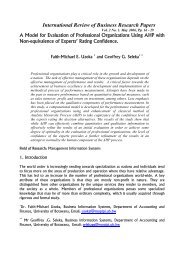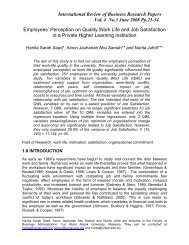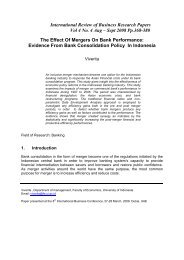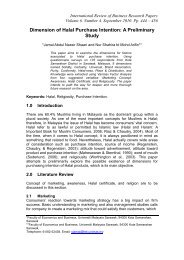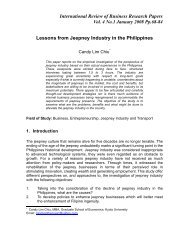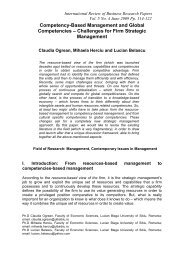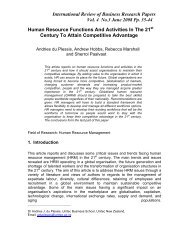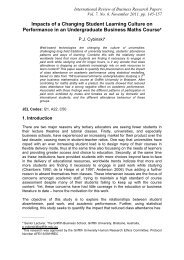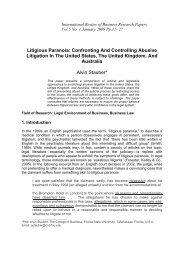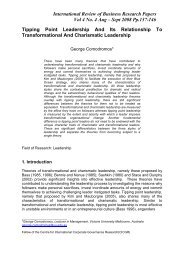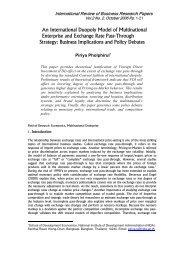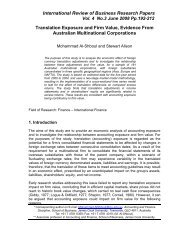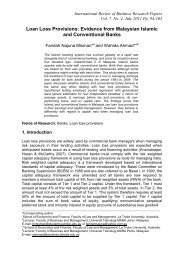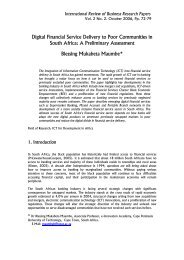Modelling Naira/Dollar Exchange Rate Volatility - International ...
Modelling Naira/Dollar Exchange Rate Volatility - International ...
Modelling Naira/Dollar Exchange Rate Volatility - International ...
Create successful ePaper yourself
Turn your PDF publications into a flip-book with our unique Google optimized e-Paper software.
<strong>International</strong> Review of Business Research Papers<br />
Vol. 5 No. 3 April 2009 Pp. 377- 398<br />
<strong>Modelling</strong> <strong>Naira</strong>/<strong>Dollar</strong> <strong>Exchange</strong> <strong>Rate</strong> <strong>Volatility</strong>: Application<br />
Of Garch And Assymetric Models<br />
Olowe, Rufus Ayodeji 1<br />
This paper investigated the volatility of <strong>Naira</strong>/<strong>Dollar</strong> exchange rates in Nigeria<br />
using GARCH (1,1), GJR-GARCH(1,1), EGARCH(1,1), APARCH(1,1),<br />
IGARCH(1,1) and TS-GARCH(1,1) models. Using monthly data over the period<br />
January 1970 to December 2007, <strong>Volatility</strong> persistence and asymmetric<br />
properties are investigated for the Nigerian foreign exchange. The impact of the<br />
deregulation of Foreign exchange market on volatility was investigated by<br />
presenting results separately for the period before deregulation, Fixed exchange<br />
rate period (January 1970- August 2006) and managed float regime (September<br />
2006 - December 2007). The results from all the models show that volatility is<br />
persistent. The result is the same for the fixed exchange rate period and<br />
managed float rate regime. The results from all the asymmetry models rejected<br />
the hypothesis of leverage effect. This is in contrast to the work of Nelson (1991).<br />
The APARCH model and GJR-GARCH model for the managed floating rate<br />
regime show the existence of statistically significant asymmetry effect. The TS-<br />
GARCH and APARCH models are found to be the best models.<br />
1. Introduction<br />
Prior to the introduction of structural adjustment programme in Nigeria in 1986, the<br />
country adopted a fixed exchange rate regime supported by exchange control<br />
regulations that engendered significant distortions in the economy. The country<br />
depends heavily on imports from various countries as most industries in Nigeria import<br />
their raw materials from foreign countries. Apart from raw materials, there were massive<br />
importation of finished goods with the adverse consequences for domestic production,<br />
balance of payments position and the nation’s external reserves level (Sanusi, 2004).<br />
The foreign exchange market in the fixed exchange rate period was characterized by<br />
high demand for foreign exchange which can not be adequately met with the supply of<br />
foreign exchange by the Central Bank of Nigeria (CBN). The fixed exchange rate period<br />
was also characterised by sharp practices perpetrated by dealers and end-users of<br />
foreign exchange (Sanusi, 2004). The inadequate supply of foreign exchange by the<br />
CBN promoted the parallel market for foreign exchange and created uncertainty in<br />
foreign exchange rates. The introduction of SAP in Nigeria in September 1986 which<br />
deregulated the foreign exchange market led to the introduction of market determined<br />
exchange rate, managed floating rate regime. The CBN usually intervene in foreign<br />
exchange market through its monetary policy actions and operations in the money<br />
market to influence the exchange rate movement in the desired direction such that it<br />
ensures the competitiveness of the domestic economy. This introduction of managed<br />
1 Department of finance, University of Lagos, Akoka, Lagos, Nigeria. E-mail: raolowe@yahoo.co.uk
Olowe<br />
floating rate regime tends to increase the uncertainty in exchange rates, thus,<br />
increasing the volatility of exchange rate by the regime shifts. This made the exchange<br />
rate to be the most important asset price in the economy. The understanding of the<br />
behaviour of exchange rate behaviour is important to monetary policy (Longmore and<br />
Robinson, 2004). The exchange rate has been found to be an important element in the<br />
monetary transmission process [Robinson and Robinson (1997), Allen and Robinson<br />
(2004)]and movements in this price has a significant pass-through to consumer prices<br />
(see Robinson (2000a and 2000b) and McFarlane (2002)). According to Longmore and<br />
Robinson (2004), because of the thinness and volatility of the market, the policy makers<br />
focus on the information content of the short-term volatility especially in deciding<br />
intervention policy. The uncertainty of the exchange rate shows how much economic<br />
behaviors are not able to perceive the directionality of the actual or future volatility of<br />
exchange rate, that is, it is a different concept from the volatility of the exchange rate<br />
itself in that it means that the more forecast errors of economic behaviors made, the<br />
higher the trends in the uncertainty of the exchange rate are shown (Yoon and Lee,<br />
2008).<br />
The volatility of financial assets has been of growing area of research(see Longmore<br />
and Robinson (2004) among others). The traditional measure of volatility as represented<br />
by variance or standard deviation is unconditional and does not recognize that there are<br />
interesting patterns in asset volatility; e.g., time-varying and clustering properties.<br />
Researchers have introduced various models to explain and predict these patterns in<br />
volatility. .Engle (1982) introduced the autoregressive conditional heteroskedasticity<br />
(ARCH) to model volatility. Engle (1982) modeled the heteroskedasticity by relating the<br />
conditional variance of the disturbance term to the linear combination of the squared<br />
disturbances in the recent past. Bollerslev (1986) generalized the ARCH model by<br />
modeling the conditional variance to depend on its lagged values as well as squared<br />
lagged values of disturbance, which is called generalized autoregressive conditional<br />
heteroskedasticity (GARCH) . Since the work of Engle (1982) and Bollerslev (1986),<br />
various variants of GARCH model have been developed to model volatility. Some of the<br />
models include IGARCH originally proposed by Engle and Bollerslev (1986), GARCHin-Mean<br />
(GARCH-M) model introduced by Engle, Lilien and Robins (1987),the standard<br />
deviation GARCH model introduced by Taylor (1986) and Schwert (1989), the<br />
EGARCH or Exponential GARCH model proposed by Nelson (1991), TARCH or<br />
Threshold ARCH and Threshold GARCH were introduced independently by Zakoïan<br />
(1994) and Glosten, Jaganathan, and Runkle (1993), the Power ARCH model<br />
generalised by Ding, Zhuanxin, C. W. J. Granger, and R. F. Engle (1993) among others.<br />
The modeling and forecasting of exchange rates and their volatility has important<br />
implications for many issues in economics and finance. Various family of GARCH models<br />
have been applied in the modeling of the volatility of exchange rates in various<br />
countries. Taylor (1987) and more recently West and Chow (1995) examined the forecast<br />
ability of exchange rate volatility using a number of models including ARCH using five<br />
U.S. bilateral exchange rate series. They found that generalised ARCH (GARCH) models<br />
were preferable at a one week horizon, whilst for less frequent data, no clear victor was<br />
evident. Some other studies on the volatility of exchange rates include Meese and Rose<br />
378
Olowe<br />
(1991), McKenzie (1997), Christian (1998), Longmore and Wayne Robinson (2004),<br />
Yang(2006) Yoon and Lee (2008) among others. Little or no work has been done on<br />
modeling exchange rate volatility in Nigeria particularly using GARCH models. This paper<br />
attempts to fill this gap. The exchange rate volatility has implications for many issues in the<br />
arena of finance and economics. Such issues include impact of foreign exchange rate<br />
volatility on derivative pricing, global trade patterns, countries balance of payments<br />
position, government policy making decisions and international capital budgeting.<br />
The purpose of this paper is to model exchange rate volatility in Nigeria using family of<br />
GARCH models. The paper will examine the volatility and asymmetry of exchange rates<br />
in Nigeria using GARCH, TARCH, EGARCH, the standard deviation GARCH, Power<br />
ARCH and IGARCH models. The deregulation of foreign exchange market in Nigeria in<br />
September 1986 could have affected the volatility of exchange rates in Nigeria. This<br />
paper, apart from presenting full sample results, will separate present the results of<br />
volatility in a fixed exchange rate regime and floating exchange rate regime. The rest of<br />
this paper is organised as follows: Chapter two discusses Theoretical background and<br />
literature review on models of time varying volatility while Chapter three discusses<br />
methodology. The results are presented in Chapter four while concluding remarks are<br />
presented in Chapter five.<br />
2. Literature Review On Models Of Time Varying <strong>Volatility</strong><br />
The need of long lag to improve the goodness of fit when we adopt the<br />
autoregressive conditional heteroskedasticity (ARCH) model occurs at times. To<br />
overcome this problem, Bollerslev (1986) suggested the generalized ARCH (GARCH)<br />
model, which means that it is a generalized version of ARCH. The GARCH model<br />
considers conditional variance to be a linear combination between squired of residual<br />
and a part of lag of conditional variance. This simple and useful GARCH is the dominant<br />
model applied to financial time series analysis by the parsimony principle. GARCH (1,1)<br />
model can be summarized as follows:<br />
2<br />
s t = b 0 + ε t ε / φ ~ N(0, σ )<br />
(1)<br />
t t−1 t<br />
p<br />
q<br />
2 2 2<br />
t i t−i j t−j<br />
i= 1 j=<br />
1<br />
∑ ∑ (2)<br />
σ =ω+ αε + βσ<br />
where, σ 2 is conditional variance of ε t and ω > 0, α ≥ 0 , β ≥ 0 . Equation (2) shows that<br />
the conditional variance is explained by past shocks or volatility (ARCH term) and past<br />
variances (the GARCH term). Equation (2) will be stationary if the persistent of volatility<br />
shocks,<br />
p q<br />
∑α+ i ∑ βj<br />
is lesser than 1 and in the case it comes much closer to 1, volatility<br />
i= 1 j=<br />
1<br />
shocks will be much more persistent. As the sum of α and β becomes close to unity,<br />
shocks die out rather slowly (see Bollerslev (1986)). To complete the basic ARCH<br />
specification, we require an assumption about the conditional distribution of the error<br />
term . There are three assumptions commonly employed when working with ARCH<br />
models: normal (Gaussian) distribution, Student’s t-distribution, and Bollerslev (1986,<br />
379
Olowe<br />
1987), Engle and Bollerslev (1986) suggest that GARCH(1,1) is adequate in modeling<br />
conditional variance.<br />
The GARCH model has a distinctive advantage in that it can track the fat tail of asset<br />
returns or the volatility clustering phenomenon very efficiently (Yoon and Lee, 2008). The<br />
normality assumption for the error term in (1) is adopted for most research papers using<br />
ARCH. However, other distributional assumptions such as Student’s t-distribution and<br />
General error distribution can also be assumed. Bollerslev (1987) claims that for some<br />
data the fat-tailed property can be approximated more accurately by a conditional<br />
Students-distribution. If in Equation (1), sum of α and β is equal to 1, then shocks to<br />
volatility persist forever, and the unconditional variance is not determined by the model.<br />
Engle and Bollerslev (1986) call this type of process 'Integrated-GARCH'. They call this<br />
model the integrated GARCH' or IGARCH' model. The IGARCH model is, thus, given as<br />
follows:<br />
such that<br />
p<br />
q<br />
2 2 2<br />
t i t−i j t−j<br />
i= 1 j=<br />
1<br />
∑ ∑ (3)<br />
σ = αε + βσ<br />
p<br />
q<br />
2 2<br />
i t−i j t−j<br />
i= 1 j=<br />
1<br />
∑αε + ∑ βσ = 1<br />
(4)<br />
The impacts of variance shocks remain forever in the IGARCH model, in contrast to the<br />
stationary variance case. A weakness of the GARCH model is that the conditional<br />
variance is merely dependent on the magnitude of the previous error term and is not<br />
related to its sign. It does not account for skewness or asymmetry associated with a<br />
distribution. Thus, GARCH model can not reflect leverage effects, a kind of asymmetric<br />
information effects that have more crucial impact on volatility when negative shocks<br />
happen than positive shocks do (Yoon and Lee, 2008).<br />
Because of this weakness of GARCH model, a number of extensions of the GARCH (p,<br />
q) model have been developed to explicitly account for the skewness or asymmetry. The<br />
popular models of asymmetric volatility includes, the exponential GARCH (EGARCH)<br />
model, Glosten, Jogannathan, and Rankle (1992) GJR-GARCH model, asymmetric<br />
power ARCH (APARCH), Zakoian (1994) threshold ARCH (TARCH). The TS-GARCH<br />
advanced by Taylor (1986) and Schwert (1990), Ding, Zhuanxin, C. W. J. Granger, and<br />
R. F. Engle (1993) generalized power ARCH model, the generalized version of Higgins<br />
and Bera (1992) non-linear ARCH (NGARCH) among others.The TS-GARCH model<br />
developed by Taylor (1986) and Schwert (1990) is a popular model used to capture the<br />
information content in the thick tails, which is common in the return distribution of<br />
speculative prices. The specification of this model is based on standard deviations and is<br />
as follows:<br />
p<br />
t i t−i j t−<br />
j<br />
i= 1 j=<br />
1<br />
q<br />
∑ ∑ (5)<br />
σ =ω+ α ε + βσ<br />
The GJR-GARCH (p, q) model was introduced by Glosten, Jagannathan and Runkle<br />
(1993) to allow for allows asymmetric effects. The model is given as:<br />
380
Olowe<br />
p q r<br />
2 2 2 2<br />
t i t i j t j k t kI −<br />
− − − t−k<br />
i= 1 j= 1 k=<br />
1<br />
∑ ∑ ∑ (6)<br />
σ =ω+ αε + βσ + γ ε<br />
where I − t<br />
(a dummy variable) = 1 if ε t < 0 and 0 otherwise.<br />
In the GJR-GARCH model, good news ε t-i >0 and bad news, ε t-i < 0, have differential<br />
effects on the conditional variance; good news has an impact of α i while bad news has<br />
an impact of α i + γ. If γ i > 0, bad news increases volatility, and there is a leverage effect<br />
for the i-th order. If γ ≠0, the news impact is asymmetric (see Glosten, Jagannathan and<br />
Runkle (1993)). The exponential GARCH (EGARCH) model advanced by Nelson (1991)<br />
is the earliest extension of the GARCH model that incorporates asymmetric effects in<br />
returns from speculative prices. The EGARCH model is defined as follows:<br />
p q r<br />
2 εt−i<br />
2<br />
2 εt−k<br />
log( σ<br />
t) =ω+ ∑αi − + ∑βjlog( σ<br />
t−<br />
j)<br />
+ ∑ γk<br />
(7)<br />
σ π σ<br />
i= 1 t−i<br />
j= 1 k=<br />
1<br />
where ω, α i , β j and γ k are constant parameters. The EGARCH(p,q) model, unlike the<br />
GARCH (p, q) model, indicates that the conditional variance is an exponential function,<br />
thereby removing the need for restrictions on the parameters to ensure positive<br />
conditional variance. The asymmetric effect of past shocks is captured by the γ<br />
coefficient, which is usually negative, that is, cetteris paribus positive shocks generate<br />
less volatility than negative shocks (Longmore and Robinson, 2004). The leverage effect<br />
can be tested if γ < 0. If γ ≠ 0, the news impact is asymmetric.<br />
The asymmetry power ARCH (APARCH) model of Ding, Granger and Engle (1993) also<br />
allows for asymmetric effects of shocks on the conditional volatility. Unlike other GARCH<br />
models, in the APARCH model, the power parameter of the standard deviation can be<br />
estimated rather than imposed, and the optional γ parameters are added to capture<br />
asymmetry of up to order r. The APARCH (p, q) model is given as:<br />
p<br />
q<br />
δ δ δ<br />
t i( t−i i t−i)<br />
j t−j<br />
i= 1 j=<br />
1<br />
∑ ∑ (8)<br />
σ =ω+ α ε −γ ε + βσ<br />
where δ >0, γi ≤ 1 for i =1, …, r, γ i = 0 for all I > r, and r ≤ p<br />
If γ ≠ 0, the news impact is asymmetric.<br />
The introduction and estimation of the power term in the APARCH model is an attempt<br />
to account for the true distribution underlying volatility. The idea behind the introduction<br />
of a power term arose from the fact that, The assumption of normality in modeling<br />
financial data, which restricts d to either 1 or 2, is often unrealistic due to significant<br />
skewness and kurtosis(Longmore and Robinson, 2004).. Allowing d to take the form of a<br />
free parameter to be estimated removes this arbitrary restriction.<br />
3. METHODOLOGY<br />
3.1 THE DATA<br />
The time series data used in this analysis consists of the average monthly <strong>Naira</strong>/<strong>Dollar</strong><br />
exchange rate from January 1970 to December 2007 obtained from various issues of<br />
t−k<br />
381
Olowe<br />
the statistical bulletin and annual report of the Central Bank of Nigeria. The 2007 data<br />
was downloaded from the website of the Central Bank of Nigeria. In this study, the<br />
return on exchange rate is defined as:<br />
⎛ e ⎞<br />
t<br />
r t = log⎜<br />
⎟<br />
(9)<br />
et − 1<br />
⎝ ⎠<br />
where e t mean <strong>Naira</strong>/dollar exchange rate at time t and e t-1 represent naira exchange<br />
rate at time t-1. The r t of Equation (9) will be used in investigating the volatility of<br />
exchange rate in Nigeria over the period, 1970 - 2007. The foreign exchange market<br />
was deregulated in Nigeria in September 29, 1986. To examine the impact of the<br />
deregulation on volatility, results will be presented separately for the period before<br />
deregulation, Fixed exchange rate period (January 1970- August 2006) and managed<br />
float regime (September 2006 - December 2007).<br />
3.2 PROPERTIES OF THE DATA<br />
The summary statistics of the exchange rate return series is given in Table 1. The mean<br />
return for the full sample, pre-deregulation era and deregulation are 0.0112, 0.0031 and<br />
0.0175 respectively while their standard deviations are 0.095, 0.0265 and 0.1242<br />
respectively. The standard deviation appears to be higher after the market has been<br />
deregulated following the introduction of market determined exchange rates. The<br />
skewness for the full sample and the two sub periods (Fixed rate and Managed floating<br />
rate regimes) are 11.6686, 0.531and 9.1498 respectively. This shows that the<br />
distribution is positively skewed relative to the normal distribution (0 for the normal<br />
distribution). This is an indication of a non symmetric series. The kurtosis for the full<br />
sample and the two sub periods (Fixed rate and Managed floating rate regimes) are<br />
very much larger than 3, the kurtosis for a normal distribution. Skewness indicates nonnormality,<br />
while the relatively large kurtosis suggests that distribution of the return series<br />
is leptokurtic, signaling the necessity of a peaked distribution to describe this series.<br />
This suggests that for the exchange rate return series, large market surprises of either<br />
sign are more likely to be observed, at least unconditionally. The Ljung-Box test Q<br />
statistics for the full sample and the two sub periods (Fixed rate and Managed floating<br />
rate regimes) are all insignificant at the 5% for all reported lags confirming the absence<br />
of autocorrelation in the exchange rate return series. Jarque-Bera normality test rejects<br />
the hypothesis of normality for the full sample and the two sub periods (Fixed rate and<br />
managed floating rate regimes). Figures 1, 2 and 3 shows the quantile-quantile plots of<br />
the exchange rate return for the for the full sample and the two sub periods (Fixed rate<br />
and Managed floating rate regimes). Figures 1, 2 and 3 clearly show that the distribution<br />
of the exchange rate return series show a strong departure from normality.<br />
The usual method of testing for testing for conditional homoscedasticity by calculating the<br />
autocorrelation of the squared return series might not be appropriate here in view of the<br />
non-normality of the exchange rate return series (see Mckenzie (1997)). According to<br />
Mckenzie (1997), volatility clustering is by no means unique to the squared returns of an<br />
assets price. In general, the absolute changes in an assets price will exhibit volatility<br />
clustering and the inclusion of any power term acts so as to emphasise the periods of<br />
relative tranquility and volatility by highlighting the outliers in that series. It is possible to<br />
382
Olowe<br />
specify any power term to complete this task from a myriad of options inclusive of any<br />
positive value (Mckenzie, 1997). The common use of a squared term is most likely a<br />
reflection of the normality assumption made regarding the data. If a data series is<br />
normally distributed, then we are able to completely characterise its distribution by its<br />
first two moments. As such, it may be appropriate to focus on a squared term. However,<br />
if we accept that the data has a non-normal error distribution, then one must transcend<br />
into the realm of the higher moments of skewness and kurtosis to adequately describe<br />
the data. In this instance, the intuitive appeal of a squared term is lost and other power<br />
transformations may be more appropriate (Mckenzie, 1997).<br />
Following, Mckenzie (1997), the test for conditional homoscedasticity was carried out by<br />
calculating the autocorrelation of power transformed exchange rate return series using<br />
powers of 0.25, 0.5 and 0.75. The Ljung-Box Q 0.25 and Q 0.5 statistics for the full sample<br />
and the two sub periods (Fixed rate and Managed floating rate regimes) are significant<br />
at the 5% for all reported lags confirming the presence of heteroscedasticity in the<br />
exchange rate return series. The Ljung-Box Q 0.75 statistics are significant at the 5% level<br />
for the full sample and first sub-period (fixed exchange rate period). However, the Ljung-<br />
Box test Q 0.75 statistics are insignificant at the 5% level for all lags for the second subperiod.<br />
In view of the insignificance of the Ljung-Box Q 0.25 and Q 0.5 test statistics for the<br />
second sub-period, it will be safer to reject conditional homoscedasticity for this sub<br />
period too.<br />
Table 3 shows the results of unit root test for the exchange rate return series. The<br />
Augmented Dickey-Fuller test and Phillips-Perron test statistics for the exchange rate<br />
return series are less than their critical values at the 1%, 5% and 10% level. This shows<br />
that the exchange rate return series has no unit root. Thus, there is no need to<br />
difference the data.<br />
383
Olowe<br />
Table 1: Summary Statistics and Autocorrelation of the Raw <strong>Exchange</strong> <strong>Rate</strong> Return<br />
Series<br />
Full<br />
Sample<br />
Fixed rate<br />
regime<br />
Managed<br />
Float<br />
Summary Statistics<br />
Mean 0.011 0.003 0.018<br />
Standard<br />
0.095 0.027 0.124<br />
Deviation<br />
Skewness 11.669 0.531 9.150<br />
Kurtosis 156.958 19.709 93.834<br />
Jarque-Bera 459695.000 2324.390 91581.100<br />
(0.000)* (0.000)* (0.000)*<br />
Observation 455 199 256<br />
Ljung-Box Q Statistics<br />
Q(1) 0.025 4.555 0.079<br />
(0.870) (0.033)* (0.779)<br />
Q(6) 1.587 26.876 2.061<br />
(0.950) (0.000)* (0.914)<br />
Q(12) 2.485 30.396 2.410<br />
(1.000) (0.002)* (0.998)<br />
Q(20) 2.794 34.579 2.819<br />
(1.000) (0.022)* (1.000)<br />
Notes: p values are in parentheses. * indicates significance at the 5% level<br />
Figure 1:<br />
Quantile-Quantile Plot of <strong>Exchange</strong> <strong>Rate</strong> Return Series Based on the Full<br />
Sample ( January 1970 – December 2007)<br />
384
Olowe<br />
.4<br />
.3<br />
Quantiles of Normal<br />
.2<br />
.1<br />
.0<br />
-.1<br />
-.2<br />
-.3<br />
-0.4 0.0 0.4 0.8 1.2 1.6<br />
Quantiles of <strong>Exchange</strong> <strong>Rate</strong> Return<br />
Figure 2:<br />
Quantile-Quantile Plot of <strong>Exchange</strong> <strong>Rate</strong> Return Series Based for the<br />
Fixed <strong>Exchange</strong> <strong>Rate</strong> Regime ( January 1970 – August 1986)<br />
.08<br />
.06<br />
.04<br />
Quantiles of Normal<br />
.02<br />
.00<br />
-.02<br />
-.04<br />
-.06<br />
-.08<br />
-.2 -.1 .0 .1 .2<br />
Quantiles of <strong>Exchange</strong> <strong>Rate</strong> Return<br />
Figure 3:<br />
Quantile-Quantile Plot of <strong>Exchange</strong> <strong>Rate</strong> Return Series Based for the<br />
Managed Floating <strong>Rate</strong> Regime ( September 1986 – December 2007)<br />
385
Olowe<br />
.4<br />
.3<br />
.2<br />
Quantiles of Normal<br />
.1<br />
.0<br />
-.1<br />
-.2<br />
-.3<br />
-.4<br />
-0.4 0.0 0.4 0.8 1.2 1.6<br />
Quantiles of <strong>Exchange</strong> <strong>Rate</strong> Return<br />
Table 2: Autocorrelation of the Power transformed Return series using Powers of<br />
0.25, 0.5 and 0.75<br />
Full<br />
Sample<br />
Fixed rate<br />
regime<br />
Managed<br />
Float<br />
Ljung-Box Q 0.25 Statistics<br />
Q 0.25 ( 6) 377.980 153.040 196.680<br />
Q 0.25 (<br />
12)<br />
Q 0.25 (<br />
20)<br />
(0.000)* (0.000)* (0.000)*<br />
635.100 228.040 341.650<br />
(0.000)* (0.000)* (0.000)*<br />
859.980 294.890 460.770<br />
(0.000)* (0.000)* (0.000)*<br />
Ljung-Box Q 0.5 Statistics<br />
Q 0.5 ( 6) 104.890 92.210 32.219<br />
(0.000)* (0.000)* (0.000)*<br />
Q 0.5 ( 12) 165.240 126.140 53.307<br />
(0.000)* (0.000)* (0.000)*<br />
Q 0.5 ( 20) 202.040 160.290 63.425<br />
(0.000)* (0.000)* (0.000)*<br />
Ljung-Box Q 0.75 Statistics<br />
Q 0.75 ( 6) 17.670 55.215 3.932<br />
(0.007)* (0.000)* (0.686)<br />
Q 0.75 (<br />
12)<br />
25.461 67.201 6.189<br />
(0.013)* (0.000)* (0.906)<br />
Q 0.75 ( 26.991 78.754 6.397<br />
386
Olowe<br />
20)<br />
(0.036)* (0.000)* (0.998)<br />
Notes: p values are in parentheses. * indicates significance at the 5% level<br />
Table 3: Unit Root Test of the <strong>Exchange</strong> rate Return Series over the period,<br />
January 1970-December 2007<br />
Augmented Dickey-Fuller test Phillips-Perron test<br />
Statistic Critical Values (% Statistic Critical Values (%<br />
level)<br />
level)<br />
1% 5% 10% 1% 5% 10%<br />
Full Sample -21.145 -2.570 -1.942 -1.616 -21.147 -2.570 -1.942 -1.616<br />
Fixed rate -7.588 -2.577 -1.942 -1.616 -16.001 -2.577 -1.942 -1.616<br />
regime<br />
Managed Float -15.790 -2.574 -1.942 -1.616 -15.789 -2.574 -1.942 -1.616<br />
Notes: The appropriate lags are automatically selected employing Akaike information<br />
Criterion<br />
In summary, the analysis of the exchange rate return indicates that the empirical<br />
distribution of returns in the foreign exchange rate market is non-normal, with very thick<br />
tails for the full sample and the two sub periods (Fixed rate and managed floating rate<br />
regimes). The leptokurtosis reflects the fact that the market is characterised by very<br />
frequent medium or large changes. These changes occur with greater frequency than<br />
what is predicted by the normal distribution. The empirical distribution confirms the<br />
presence of a non-constant variance or volatility clustering.<br />
3.2 MODELS USED IN THIS STUDY<br />
This study will attempt to model the volatility of monthly exchange rates return. The<br />
mean equation that will be used in this study is given as:<br />
2<br />
r t = c + ε t εt / φt−<br />
1<br />
~ t(0, σ<br />
t,v t)<br />
(10)<br />
where v t is the degree of freedom<br />
On September 29, 1986, the foreign exchange market was deregulated in Nigeria<br />
paving the way for the introduction of market determined exchange rates (managed<br />
floating exchange rate). To account for the introduction of managed floating exchange<br />
rate system, this paper introduced a dummy variable which is set equal to 0 for the<br />
period before the introduction of managed floating exchange rate and 1 thereafter.<br />
Thus, for the full sample, Equation (9) is adjusted as:<br />
2<br />
r t = c + dum1+ ε t ε / φ ~ t(0, σ ,v )<br />
(11)<br />
t t−1 t t<br />
For the two sub-periods, Fixed/Pegged exchange rate regime and Floating exchange<br />
rate regime, Equation (9) will still be used as the mean equation.<br />
The volatility models used in this study include:<br />
387
Olowe<br />
2 2 2<br />
GARCH (1, 1): σ<br />
t<br />
=ω+αε<br />
t−1+βσ t−1<br />
(12)<br />
2 2 2<br />
IGARCH(1, 1): σ<br />
t<br />
=αε<br />
t−1+βσ t−1<br />
with α + β =1 (13)<br />
TS-GARCH(1,1): σ<br />
t<br />
=ω+αε<br />
t−1 +βσ<br />
t−1<br />
(14)<br />
GJR-GARCH(1,1):<br />
2 2<br />
σ =ω+αε<br />
2<br />
+βσ<br />
2<br />
+γε I −<br />
(15)<br />
EGARCH (1,1):<br />
t t−1 t−1 t−1 t−1<br />
ε 2<br />
ε<br />
log( σ ) =ω+α − +βlog( σ ) +γ<br />
2 t−1 2<br />
t−1<br />
t t−1<br />
σt−<br />
1<br />
π σt−<br />
1<br />
σ δ =ω+α( ε )<br />
δ δ<br />
−<br />
−γε<br />
−<br />
+βσ<br />
−<br />
APARCH(1,1) :<br />
t t 1 t 1 t 1<br />
(17)<br />
The volatility parameters to be estimated include ω, α, β, γ and δ. As the exchange rate<br />
return series shows a strong departure from normality, all the models will be estimated<br />
with Student t as the conditional distribution for errors. The estimation will be done in<br />
such a way as to achieve convergence. Where necessary, the Student t will be chosen<br />
with a fixed degree of freedom so as to achieve convergence. All the models will be<br />
evaluated using the Akaike, Schwarz and Hannan-Quinn criteria.<br />
4. THE RESULTS<br />
The results of estimating Equations(10) to (17) are presented in Tables 4, 5 and 6.<br />
Table 1 shows the result for the full sample over the period January 1970-December<br />
2007. Table 5 shows the result for the first sub-period (Fixed rate regime) over the<br />
period, January 1970-August 1986 while Table 6 shows the result for the second subperiod<br />
(Managed floating rate regime) over the period, September 2006 - December<br />
2007.<br />
Table 4 shows that, in the mean equation, the coefficient of the dummy variable (proxy<br />
for change from fixed rate regime to managed float ) is not significant at the 5% level in<br />
the GARCH, EGARCH and APARCH models but significant in the GJR-GARCH,<br />
IGARCH and TS-GARCH models. This shows that the impact of change from the fixed<br />
rate regime to managed float depends on the choice of model. The change to managed<br />
float regime is important in only the GJR-GARCH, IGARCH and TS-GARCH models.<br />
The variance equation of Table 4 shows that α, the coefficient is not statistically<br />
significant in the GARCH and EGARCH models but significant at the 5% level in GJR-<br />
GARCH, APARCH, IGARCH and TS-GARCH models. This appears to show the<br />
presence of volatility clustering in GJR-GARCH, APARCH, IGARCH and TS-GARCH<br />
models. Conditional volatility for these models tends to rise (fall) when the absolute<br />
value of the standardized residuals is larger (smaller). A breakdown of the results shows<br />
that the statistical coefficients of α in Table 5 (Fixed rate period) are similar to those in<br />
Table 4 for all models. However, in Table 6 (managed floating rate regime), the<br />
coefficients of α are statistically significant at the 5% level in the APARCH, IGARCH and<br />
(16)<br />
388
Olowe<br />
TS-GARCH models. This shows that the shift from fixed rate regime to managed float<br />
affected the statistical significance of α\ in the GJR-GARCH model.<br />
Table 4 shows that the coefficients of β (a determinant of the degree of persistence) are<br />
statistically significant in all models. This result for the coefficient of β is the same for the<br />
two sub periods (Fixed rate and managed float regime) as shown in Tables 5 and 6<br />
showing the shift from fixed rate regime to managed float did not affect the statistical<br />
significance of β. The sum of α and β in the GARCH model in Tables 4, 5 and 6<br />
exceeds 1. This appears to show that the shocks to volatility are very high and will<br />
remain forever as the variances are not stationary under the GARCH model. However,<br />
in view of the insignificance of α in the GARCH model, the result is inconclusive. In the<br />
GJR-GARCH and APARCH models of Tables 4, 5 and 6 , α+β +(γ/2) exceeds 1. This<br />
also appears to show that the shocks to volatility are very high and the variances are<br />
not stationary under the GJR-GARCH and APARCH models. However, the EGARCH<br />
models of Tables 4, 5 and 6 have their βs below 1 showing persistent volatility in the<br />
EGARCH model. IGARCH model is already modeled to have α+β equal to 1. The<br />
results in Tables 4, 5 and 6 show that IGARCH model fit our exchange rate return data<br />
as both the α and β are statistically significant at the 5% level. The IGARCH model also<br />
shows that variances are not stationary and persistence of volatility will remain forever.<br />
The sum of α and β in the TS-GARCH model in Tables 4, 5 and 6 exceeds 1. This<br />
appears to show that the shocks to volatility are very high and will remain forever as the<br />
variances are not stationary under the TS-GARCH model. The volatility persistence for<br />
the GARCH, GJR-GARCH and E-GARCH models in Table 5 are higher than those of<br />
Table 6 indicating that volatility persistence is higher in the Managed floating rate<br />
regime than Fixed rate regime. However, in view of the insignificance of α in the<br />
GARCH model and GJR-model of Table 6, this result is inconclusive. The APARCH and<br />
TS-GARCH models have their volatility persistence higher in Table 5 compared to Table<br />
6 showing that a shift from fixed rate regime to reduces volatility persistence. However,<br />
in sum, the Nigerian Foreign exchange market is characterized by high volatility<br />
persistence.<br />
389
Olowe<br />
Table 4:<br />
Parameter Estimates of GARCH Models For the Full Sample, January<br />
1970 - December 2007<br />
GARCH GJR-GARCH EGARCH APARCH IGARCH TS-GARCH<br />
Mean Equation<br />
c 0.000 0.000 0.000 0.000 0.000 0.000<br />
(0.000)* (0.000)* (0.001) (0.000) (0.000)* (0.000)*<br />
dum1 0.000 0.000 0.000 0.000 0.000 0.000<br />
(0.000) (0.000)* (0.001) (0.000) (0.000)* (0.000)*<br />
Variance Equation<br />
ω 0.000 0.000 -2.047 0.007 0.000<br />
(0.000) (0.000) (0.572)* (0.005) (0.000)<br />
α 8.363 3.892 1.090 1.477 0.288 2.117<br />
(5.480) (0.482)* (1.128) (0.490)* (0.005)* (0.649)*<br />
β 0.129 0.126 0.720 0.562 0.712 0.442<br />
(0.007)* (0.008)* (0.028)* (0.020)* (0.005)* (0.012)*<br />
γ -2.547 -0.734 -0.201<br />
(0.497)* (0.769) (0.074)*<br />
δ 0.440<br />
(0.035)*<br />
v 2.130 3.000 2.027 2.008 2.170 2.079<br />
(0.095)* (0.012)* (0.017)* (0.051*<br />
LL 2170.541 1908.984 1291.976 2025.203 1642.133 2050.623<br />
Persistence 8.492 2.745 0.720 1.939 1.000 2.559<br />
AIC -9.514 -8.365 -5.648 -8.867 -7.201 -8.987<br />
SC -9.460 -8.310 -5.585 -8.794 -7.164 -8.933<br />
HQC -9.493 -8.343 -5.623 -8.838 -7.186 -8.966<br />
N 455 455 455 455 455 455<br />
Notes: Standard errors are in parentheses. * indicates significant at the 5% level.<br />
LL, AIC, SC, HQC and N are the maximum log-likelihood, Akaike information Criterion,<br />
Schwarz Criterion, Hannan-Quinn criterion and Number of observations respectively<br />
390
Olowe<br />
Table 5:<br />
Parameter Estimates of GARCH Models For the Fixed <strong>Exchange</strong> <strong>Rate</strong><br />
Regime, January 1970 - August 1986<br />
GARCH GJR-GARCH EGARCH APARCH IGARCH TS-GARCH<br />
Mean Equation<br />
Constant 0.000 0.000 0.000 0.000 0.000 0.000<br />
(0.000) (0.000) (0.000) (0.000) (0.000) (0.000)<br />
Variance Equation<br />
ω 0.000 0.000 -4.913 0.000 0.000<br />
(0.000) (0.000) (1.065)* (0.000) 0.000<br />
α 2.255 1.524 2.006 2.008 0.984 2.759<br />
(2.191) (0.211)* (2.178) (0.507)* (0.007)* (0.891)*<br />
β 0.401 0.354 0.507 0.603 0.016 0.341<br />
(0.010)* (0.008)* (0.036)* (0.027)* (0.007)* (0.010)*<br />
γ -0.770 1.632 -0.466<br />
(0.235)* (1.773) (0.072)*<br />
δ 0.636<br />
(0.054)*<br />
v 2.106 7.000 2.056 2.009 2.102 2.057<br />
(0.113)* (0.129)* (0.024)* (0.038)*<br />
L 837.244 684.366 657.542 1012.160 659.801 1013.980<br />
Persistence 2.655 1.493 0.507 2.378 1.000 3.099<br />
AIC -8.364 -6.828 -6.548 -10.102 -6.601 -10.141<br />
SC -8.282 -6.745 -6.449 -9.986 -6.551 -10.058<br />
HQC -8.331 -6.794 -6.508 -10.055 -6.581 -10.107<br />
N 199 199 199 199 199 199<br />
Notes: Standard errors are in parentheses. * indicates significant at the 5%<br />
level.<br />
LL, AIC, SC, HQC and N are the maximum log-likelihood, Akaike information Criterion,<br />
Schwarz Criterion, Hannan-Quinn criterion and Number of observations respectively<br />
391
Olowe<br />
Table 6: Parameter Estimates of GARCH Models For the Managed Floating <strong>Rate</strong><br />
Regime, September 1986 - December 2007<br />
GARCH GJR-GARCH EGARCH APARCH IGARCH TS-GARCH<br />
Mean Equation<br />
Constant 0.000 0.000 0.000 0.000 0.000 0.000<br />
(0.000) (0.000) (0.001) (0.000) (0.000)* (0.000)<br />
Variance Equation<br />
ω 0.000 0.000 -3.396 0.030 0.000<br />
(0.000) (0.000) (0.913)* (0.012)* (0.000)<br />
α 6.940 7.865 1.353 1.012 0.645 1.710<br />
(5.498) (11.643) (1.121) (0.186)* (0.015)* (0.708)*<br />
β 0.096 0.043 0.534 0.447 0.355 0.448<br />
(0.010)* (0.006)* (0.049)* (0.027)* (0.015)* (0.015)*<br />
γ 1.613 -0.945 -0.303<br />
(3.532) (0.803) (0.102)*<br />
δ 0.248<br />
(0.035)*<br />
v 2.186 2.074 2.039 2.010 2.584 2.124<br />
(0.176)* (0.119)* (0.067)* (0.011)* (0.081)* (0.115)*<br />
L 1249.661 1243.049 678.881 1193.575 1076.070 1251.168<br />
Persistence 7.035 8.714 0.534 1.307 1.000 2.158<br />
AIC -9.724 -9.664 -5.257 -9.270 -8.383 -9.736<br />
SC -9.655 -9.581 -5.174 -9.173 -8.342 -9.666<br />
HQC -9.696 -9.631 -5.223 -9.231 -8.367 -9.708<br />
N 256 256 256 256 256 256<br />
Notes: Standard errors are in parentheses. * indicates significant at the 5%<br />
level.<br />
LL, AIC, SC, HQC and N are the maximum log-likelihood, Akaike information Criterion,<br />
Schwarz Criterion, Hannan-Quinn criterion and Number of observations respectively<br />
Table 4, 5 and 6 show that the coefficients of γ, the asymmetry and leverage effects,<br />
are negative and statistically significant at the 5% level in the GJR-GARCH and<br />
APARCH models but negative and insignificant in the EGARCH model. However,<br />
leverage effect will only exist if γ > 0 in the GJR-GARCH and APARCH models and γ <<br />
0 in the EGARCH. In view of the statistically insignificance of γ in the EGARCH model<br />
and negative values of γ in the GJR-GARCH and APARCH models, the hypothesis of<br />
leverage effect is rejected for all models but asymmetry effect is accepted for the GJR-<br />
GARCH and APARCH models. The results of asymmetry and leverage effects are the<br />
same for the fixed rare and managed float regimes.<br />
The estimated coefficients of the degree of freedom, v are significant at the 5-percent<br />
level in all models of Tables 4, 5 and 6 where standard errors are stated, implying the<br />
392
Olowe<br />
appropriateness of student t distribution. Standard errors were not estimated for models<br />
estimated under the distributional assumption of student t with fixed parameter.<br />
Diagnostic checks<br />
Tables 7, 8 and 9 shows the results of the diagnostic checks on the estimated models in<br />
Tables 4, 5 and 6. Table 7 shows the results of the estimated checks on the full sample.<br />
Table 8 shows the result of the diagnostic check on the fixed rate regime and Table 9<br />
shows the result of the diagnostic check for the managed floating rate regime. Tables 7,<br />
8 and 9 show that the Ljung-Box Q-test statistics of the standardized residuals for the<br />
remaining serial correlation in the mean equation shows that autocorrelation of<br />
standardized residuals are statistically insignificant at the 5% level for all lags and<br />
models confirming the absence of serial correlation in the standardized residuals. This<br />
shows that the mean are well specified in all models in Tables 4, 5 and 6. The Ljung-<br />
Box Q 2 -statistics of the squared standardized residuals in Tables 7, 8 and 9 are all<br />
insignificant at the 5% level for all lags and models confirming the absence of ARCH in<br />
the variance equation. The ARCH-LM test statistics in Tables 7,8 and 9 for all models<br />
further showed that the standardized residuals did not exhibit additional ARCH effect.<br />
This shows that the variance equations are well specified in all models of Tables 4, 5<br />
and 6. The Jarque-Bera statistics still shows that the standardized residuals are not<br />
normally distributed. In sum, all the models are adequate for forecasting purposes.<br />
.<br />
Table 7:<br />
Autocorrelation of Standardized Residuals, Autocorrelation of Squared<br />
Standardized Residuals and ARCH LM test of Order 4 for the Full Sample<br />
Ljung-Box Q-statistics Ljung-Box Q 2 Statistics ARCH LM<br />
Q(6) Q(12) Q(20) Q 2 (6) Q 2 (12) Q 2 (20) F N*R 2 JB<br />
GARCH 0.010 0.021 0.036 0.014 0.028 0.048 0.002 0.009 3834332<br />
(1.000) (1.000) (1.000) (1.000) (1.000) (1.000) (1.000) (1.000) (0.000)<br />
GJR-GARCH 0.014 0.028 0.047 0.014 0.028 0.048 0.002 0.009 3873371<br />
(1.000) (1.000) (1.000) (1.000) (1.000) (1.000) (1.000) (1.000) (0.000)<br />
EGARCH 0.075 0.186 0.428 0.029 0.060 0.104 0.004 0.018 1640936<br />
(1.000) (1.000) (1.000) (1.000) (1.000) (1.000) (1.000) (1.000) (0.000)<br />
APARCH 0.009 0.019 0.032 0.014 0.028 0.048 0.002 0.009 3806252<br />
(1.000) (1.000) (1.000) (1.000) (1.000) (1.000) (1.000) (1.000) (0.000)<br />
IGARCH 0.014 0.028 0.047 0.014 0.028 0.048 0.002 0.009 3873367<br />
(1.000) (1.000) (1.000) (1.000) (1.000) (1.000) (1.000) (1.000) (0.000)<br />
TS-GARCH 0.013 0.026 0.045 0.014 0.028 0.048 0.002 0.009 3872038<br />
(1.000) (1.000) (1.000) (1.000) (1.000) (1.000) (1.000) (1.000) (0.000)<br />
Note: p values are in parentheses<br />
393
Olowe<br />
Table 8:<br />
Autocorrelation of Standardized Residuals, Autocorrelation of Squared<br />
Standardized Residuals and ARCH LM test of Order 4 for the Fixed<br />
<strong>Exchange</strong> <strong>Rate</strong> Regime<br />
Ljung-Box Q-statistics Ljung-Box Q 2 Statistics ARCH LM<br />
Q(6) Q(12) Q(20) Q 2 (6) Q 2 (12) Q 2 (20) F N*R 2 JB<br />
GARCH 0.127 0.265 0.453 0.115 0.242 0.414 0.019 0.076 87984.850<br />
(1.000) (1.000) (1.000) (1.000) (1.000) (1.000) (0.999) (0.999) 0.000<br />
GJR-GARCH 0.128 0.267 0.453 0.119 0.249 0.421 0.019 0.078 85239.960<br />
(1.000) (1.000) (1.000) (1.000) (1.000) (1.000) (0.999) (0.999) (0.000)<br />
EGARCH 1.029 2.576 3.709 0.396 0.744 1.272 0.067 0.273 17450.860<br />
(0.985) (0.998) (1.000) (0.999) (1.000) (1.000) (0.992) (0.992) (0.000)<br />
APARCH 0.128 0.269 0.456 0.121 0.253 0.429 0.019 0.080 83828.350<br />
(1.000) (1.000) (1.000) (1.000) (1.000) (1.000) (0.999) (0.999) (0.000)<br />
IGARCH 0.309 0.426 0.441 0.044 0.094 0.160 0.007 0.028 81994.890<br />
(0.999) (1.000) (1.000) (1.000) (1.000) (1.000) (1.000) (1.000) (0.000)<br />
TS-GARCH 0.127 0.266 0.450 0.119 0.249 0.420 0.019 0.078 85451.490<br />
(1.000) (1.000) (1.000) (1.000) (1.000) (1.000) (0.999) (0.999) (0.000)<br />
Note: p values are in parentheses<br />
Table 9:<br />
Autocorrelation of Standardized Residuals, Autocorrelation of Squared<br />
Standardized Residuals and ARCH LM test of Order 4 for the Managed<br />
Floating <strong>Rate</strong> Regime<br />
Ljung-Box Q-statistics Ljung-Box Q 2 Statistics ARCH LM<br />
Q(6) Q(12) Q(20) Q 2 (6) Q 2 (12) Q 2 (20) F N*R 2 JB<br />
GARCH 0.025 0.051 0.090 0.025 0.051 0.090 0.004 0.016 682827<br />
(1.000) (1.000) (1.000) (1.000) (1.000) (1.000) (1.000) (1.000) (0.000)<br />
GJR-GARCH 0.025 0.052 0.090 0.025 0.051 0.090 0.004 0.016 682827<br />
(1.000) (1.000) (1.000) (1.000) (1.000) (1.000) (1.000) (1.000) (0.000)<br />
EGARCH 0.144 0.356 0.653 0.034 0.070 0.121 0.005 0.022 471319<br />
(1.000) (1.000) (1.000) (1.000) (1.000) (1.000) (1.000) (1.000) (0.000)<br />
APARCH 0.025 0.057 0.095 0.025 0.051 0.090 0.004 0.016 682811<br />
(1.000) (1.000) (1.000) (1.000) (1.000) (1.000) (1.000) (1.000) (0.000)<br />
IGARCH 0.025 0.051 0.090 0.025 0.051 0.090 0.004 0.016 682827<br />
(1.000) (1.000) (1.000) (1.000) (1.000) (1.000) (1.000) (1.000) (0.000)<br />
TS-GARCH 0.025 0.051 0.090 0.025 0.051 0.090 0.004 0.016 682827<br />
(1.000) (1.000) (1.000) (1.000) (1.000) (1.000) (1.000) (1.000) (0.000)<br />
Note: p values are in parentheses<br />
Model Evaluation<br />
Table 10 shows the ranking of the models in terms of the of maximum log-likelihood,<br />
lowest Akaike information, Schwarz and Hannan-Quinn criteria The best model for the<br />
full sample in terms of maximum log-likelihood is the GARCH model. The model also<br />
has the lowest Akaike information, Schwarz and Hannan-Quinn criteria. However, the<br />
next best model is TS-GARCH followed by the APARCH model. The GARCH model<br />
marginally outperforms the TS-GARCH followed by the APARCH models in terms<br />
394
Olowe<br />
maximum log-likelihood and Akaike information, Schwarz and Hannan-Quinn criteria. In<br />
view of the statistically insignificance of α in the GARCH model, the TS-GARCH and<br />
APARCH models might be preferable for the full sample. For the sub-periods (Fixed<br />
rate regime and managed float), the TS-GARCH model outperforms other models.<br />
Table 10: Ranking of GARCH Models in Order of maximum log-likelihood, Akaike<br />
information Criterion, Schwarz Criterion, Hannan-Quinn criterion<br />
Rank Full Sample Fixed <strong>Rate</strong> Regime Managed Float<br />
1 st GARCH TS-GARCH TS-GARCH<br />
2 nd TS-GARCH APARCH GARCH<br />
3 rd APARCH GARCH GJR-GARCH<br />
4 th GJR-GARCH GJR-GARCH APARCH<br />
5 th IGARCH IGARCH IGARCH<br />
6 th EGARCH EGARCH EGARCH<br />
5. CONCLUSION<br />
This paper investigated the volatility of <strong>Naira</strong>/<strong>Dollar</strong> exchange rates in Nigeria using<br />
GARCH (1,1), GJR-GARCH(1,1), EGARCH(1,1), APARCH(1,1), IGARCH(1,1) and TS-<br />
GARCH(1,1) models. <strong>Volatility</strong> persistence and asymmetric properties are investigated<br />
for the Nigerian foreign exchange market. The impact of the deregulation of Foreign<br />
exchange market on volatility was investigated by presenting results separately for the<br />
period before deregulation, Fixed exchange rate period and managed float regime. The<br />
results from all the models show that volatility is persistent. The result is the same for<br />
the fixed exchange rate period and managed float rate regime. The results from all the<br />
asymmetry models rejected the hypothesis of leverage effect. This is in contrast to the<br />
work of Nelson (1991). The APARCH model and GJR-GARCH model for the managed<br />
floating rate regime show the existence of statistically significant asymmetry effect. The<br />
TS-GARCH and APARCH models are found to be the best models as they have all the<br />
parameters of the variance equations being significant.<br />
The high volatility persistence in the fixed exchange rate period could have been due to<br />
the import dependent nature of the Nigerian economy. The inadequate supply of foreign<br />
exchange by the Central Bank of Nigeria, the activities of foreign exchange dealers and<br />
parallel markets during could have contributed to the high volatility persistence during<br />
the fixed exchange rate period. In the managed floating rate regime, even though there<br />
is still high volatility persistence, the intervention of the Central Bank of Nigeria in the<br />
foreign exchange market could have moderated the volatility persistence during this<br />
period as shown in the APARCH and TS-GARCH models. Further research work needs<br />
395
Olowe<br />
to be done using other volatility models and higher frequency data. Researchers might<br />
also want to examine the impact of Central Bank intervention on exchange rate<br />
volatility.<br />
REFERENCES<br />
Allen, C. and W. Robinson. 2004. “Monetary Policy Rules and the Transmission<br />
Mechanism in Jamaica.” Working Paper, Bank of Jamaica.<br />
Baillie, R.T. and T. Bollerslev. 1989. “The message in daily exchange rates: A<br />
conditional-variance tale” Journal of Business and Economic Statistics 7, (3) pp.<br />
297 -305.<br />
Baillie, R.T. and T. Bollerslev. 1992. “Prediction in Dynamic models with Time<br />
Dependent Conditional Variances.” Journal of Econometrics. 52. 91-132.<br />
Bollerslev, T. 1986. “Generalized Autoregressive Conditional Hetroscedasticity.” Journal<br />
of Econometrics. 31. 307-327.<br />
Bollerslev, T., R.Y. Chou and K.F. Kroner. 1992. “ARCH <strong>Modelling</strong> in Finance.” Journal<br />
of Econometrics. 52. 5-59.<br />
Bollerslev, T. and I. Domowitz. 1993. “Trading Patterns and Prices in the Interbank<br />
Foreign <strong>Exchange</strong> Market.” Journal of Finance. 48(4). 1421-1443.<br />
Bollerslev, T, R. F. Engle and D. B. Nelson. 1994. “ARCH Models,” Chapter 49 in<br />
Robert F. Engle and Daniel L. McFadden (eds.), Handbook of Econometrics,<br />
Volume 4, Amsterdam: Elsevier<br />
Science B.V.Bollerslev, T. R. Engle and J.M. Wooldridge. 1998. “A Capital Asset Pricing<br />
Model with Time Varying Covariances”. Journal of Political Economy. 96( 1). 116<br />
– 131.<br />
Chong, C.W., M. I. Ahmad and M. Y. Abdullah. 1999. “Performance of GARCH Models<br />
in Forecasting Stock Market <strong>Volatility</strong>.” Journal of Forecasting. 18. 333-343.<br />
Dickey, D.A. and W.A. Fuller. 1979. “Distribution of the estimators for autoregressive<br />
time series with a unit root”. Journal of American Statistical Association. 74: 427-<br />
431.<br />
Ding, Z. R.F. Engle and C.W.J. Granger. 1993. “Long Memory Properties of Stock<br />
Market Returns and a New Model”. Journal of Empirical Finance. 1. 83 – 106.<br />
Engle, R. F. 1982. “Autoregressive Conditional Heteroscedasticity with Estimates of the<br />
Variance of United Kingdom Inflation.” Econometrica. 50(4). 987-1008.<br />
Engle, R.F. and K.F. Kroner. 1995. “Multivariate Simultaneous Generalized ARCH.”<br />
Econometric Theory. 11. 1122 – 150.<br />
396
Olowe<br />
Engle, R. F., D M. Lilien, and R P. Robins. 1987. “Estimating Time Varying Risk Premia<br />
in the Term Structure: The ARCH-M Model,” Econometrica, 55, 391–<br />
407.Glosten, L.R. R. Jagannathan and D. Runkle. 1993. “On the Relation<br />
between the Expected Value and the <strong>Volatility</strong> of the Nominal Excess Return on<br />
Stocks.” Journal of Finance. 48, 1779-1801.<br />
Kim, C.M. and S. Kon. 1994. “Alternative Model of Conditional Heteroscedasticity in<br />
Stock Returns.” Journal of Business. 67. 563-98.<br />
Lee, J.H.H. and M.L. King. 1993. “ A Locally Most Mean Powerful Based Score Test for<br />
ARCH and GARCH Regression Disturbances” Journal of Business and Economic<br />
Statistics,11, pp. 11 - 27.<br />
McKenzie, M.D. (1997) “ARCH <strong>Modelling</strong> of Australian Bilateral <strong>Exchange</strong> <strong>Rate</strong> Data”<br />
Applied Financial Economics, 7, pp. 147 - 164.<br />
McKenzie, M.D. 1997. “Forecasting Australian <strong>Exchange</strong> <strong>Rate</strong> <strong>Volatility</strong> : A Comparative<br />
Study Of Alternate <strong>Modelling</strong> Techniques And The Impact of Power<br />
Transformations”. MelBourne-Centre in Finance Papers, 97-10.<br />
Longmore , R., and W. Robinson. 2004. “<strong>Modelling</strong> and Forecasting <strong>Exchange</strong> <strong>Rate</strong><br />
Dynamics: An Application of Asymmetric <strong>Volatility</strong> Models”. Bank of Jamaica.<br />
Working Paper WP2004/03.<br />
Luu, J.C. and M. Martens. 2002. “Testing the mixture of Distribution H1986.<br />
Generalized Autoregressive Conditional Hetroscedasticity.” Journal of<br />
Econometrics. 31. 307-327.<br />
Lyons, R. K. 2001. “News Perspective on the FX Markets: Order Flow Analysis.”<br />
<strong>International</strong> Finance.<br />
Mark, N.C. 1995. “<strong>Exchange</strong> <strong>Rate</strong>s and Fundamentals: Evidence of<br />
Long-Horizon Predictability.” The American Economic Review. 85(1).201-218.<br />
McFarlene, L. 2002. “Consumer Price Inflation and <strong>Exchange</strong> <strong>Rate</strong> Pass-Through in<br />
Jamaica.” Bank of Jamaica.<br />
Meese, R. and K. Rogoff. 1983. “Empirical <strong>Exchange</strong> <strong>Rate</strong> Models of the Seventies: Do<br />
They Fit the Out of Sample?” Journal of <strong>International</strong> Economics. 14(1/2). 3-24.<br />
Meese, R.A. and Rose, A.K. (1991) “An Empirical Assessment of Nonlinearities in<br />
Models of <strong>Exchange</strong> <strong>Rate</strong> Determination” Review of Economic Studies (58) pp.<br />
603 -19.<br />
Nelson, D.B. 1990a. “ARCH models as Diffusion Approximations” Journal of<br />
Econometrics (45) pp. 7 - 38.<br />
Nelson, D.B. 1990b. “Stationarity and Persistence in the GARCH(1,1) model”<br />
Econometric Reviews, 6, pp. 318 - 334.<br />
397
Olowe<br />
Nelson, D.B. 1990c. “Conditional Heteroskedasticity in Asset Returns: A new approach”<br />
Econometrica, 45, pp. 347 - 370.<br />
Nelson, D.B. 1999. “Conditional Heteroskedasticity in Asset Returns : A New<br />
Approach”. Econometrica, 59, 347 – 370.<br />
Ng. V. R. Engle and M. Rothschild. 1992. “A Multi Dynamic Factor Model for Stock<br />
Returns.” Journal of Econometrics. 52. 245 – 266.<br />
Pillips, P.C.B. and P. Perron. 1988. Testing for a Unit Root in Time Series<br />
Regression.” Biometrika. 333-346.<br />
Robinson, J. and W. Robinson. 1997. “Monetary Policy and the Jamaican Economy: A<br />
Study of the Transmission Mechanism.” Bank of Jamaica.<br />
Sanusi, J. O. 2004. “<strong>Exchange</strong> <strong>Rate</strong> Mechanism: The Current Nigerian<br />
Experience.Paper Presented At A Luncheon Organised By Nigerian-British<br />
Chamber of Commerce.<br />
Schert, G.W. and P.J. Seguin. 1990. “Heteroskedasticity in Stock Returns”. Journal of<br />
Finance. 4., 1129 – 1155.<br />
Schwert, W. 1989. “Stock <strong>Volatility</strong> and Crash of ‘87,” Review of Financial Studies, 3,<br />
77–102.<br />
Taylor, S. 1986. “<strong>Modelling</strong> Financial Time Series” John Wiley & Sons, Great Britain.<br />
Taylor, S. J. 1987. “Forecasting the <strong>Volatility</strong> of Currency <strong>Exchange</strong> <strong>Rate</strong>s”<br />
<strong>International</strong> Journal of Forecasting, 3(1) pp. 159 - 70.<br />
Yoon, S. and K. S. Lee. 2008. “The <strong>Volatility</strong> and Asymmetry of Won/<strong>Dollar</strong> <strong>Exchange</strong><br />
<strong>Rate</strong>.” Journal of Social Sciences 4 (1): 7-9, 2008.<br />
Zakoïan, J. M. (1994). “Threshold Heteroskedastic Models,” Journal of Economic<br />
Dynamics and Control,18, 931-944.<br />
398



